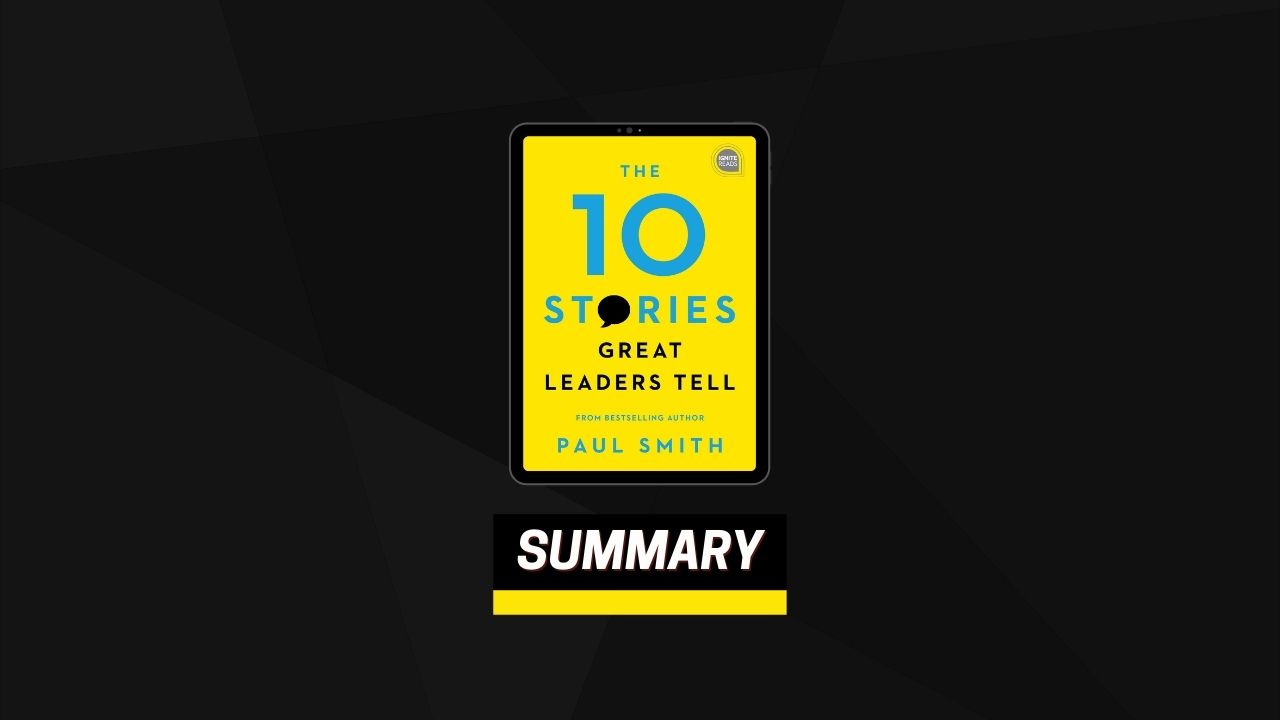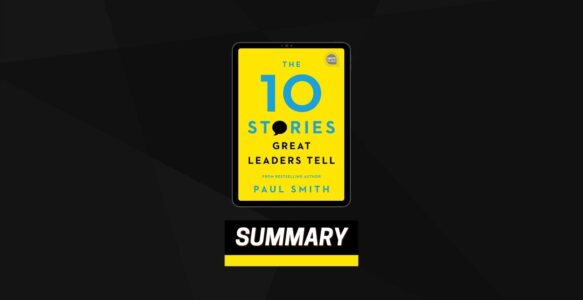As a manager, CEO, or team leader, how can you innovatively engage your employees so that they understand where your organization came from, where it’s going, and how you’re going to get there? How can you connect with your customers in a way that makes them believe in your company as passionately as you do?
Paul Smith is one of the world’s leading experts in business storytelling. He teaches people how to be more effective leaders by communicating their company’s important mission, inspiring creativity, and earning the trust of valued stakeholders.
The 10 Stories Great Leaders Tell explores the journey behind success, and breaks down not just the importance of your company’s story but how to craft compelling ones of your own.
#1 Founder Story
If you’re lucky, somebody’s already documented your company’s founding story. Find it. Check the company archives. Ask the company historian. Ask the HR department. If you’re even luckier, it’s well-crafted already. If so, read it a few times and you’re done. More likely, however, is that your founding story either doesn’t exist or it’s not very good. In that case, you’ll have to craft it yourself. If the founder’s still alive, ask for an interview. If not, ask someone else who knows the original story. Ask questions as if you were an investigative journalist. Then keep asking questions until you find yourself wanting to quit your job and start your own damn company. That’s how you’ll know you’ve got the story right. You’re looking for the pivotal moment that changed everything.
#2 Case-for-Change Story
Start by asking yourself: “Who stands to benefit from this change?” Surely, it’s good for someone or something your audience cares about, or it wouldn’t be a priority for the company.
Once you know who that is, talk to them and ask these kinds of questions:
- What’s your life or work like today (prior to making this change)?
- What problems or frustrations do you experience?
- How would your life or work be different once we implement this change ?
- What are the tangible ways you’ll know the change is working?
Whatever it is that you and your company are trying to do with this change will surely benefit someone. The point is, a story about the human impact of the change, whether that’s a benefit to the employees who have to go through the change or to your customers or to the community, will likely be more compelling than just telling people how much money it’ll save.
#3 Vision Story
Decide who your audience is. Who are you writing the vision story for? Is it for management? The rank and file? Your investors? It might be several audiences, in which case you might need several vision stories.
But for most companies, the goal of the vision is to inspire the broad set of employees. Who or what will benefit most if your vision is achieved? Is it the employees? Stockholders? Customers? The environment? The community?
Choose a fictional character either from the group your audience is in or the group that stands to benefit from the vision. Ideally, they’re both the same group. But they don’t have to be, as long as your audience cares about the group that will benefit. This will be the main character of your vision story.
Sketch out what a typical day is like for them after your vision has been achieved. Make sure to include the type of activities that are both important to your audience and heavily impacted by having achieved the vision.
#4 Strategy Story
Pick a date in the future by which your strategy should have worked. Write what amounts to a newspaper or magazine article looking back at your success.
Include the metrics of your success (revenues, profits, market share, etc.). Describe each component of your strategy in terms of how it played out, and how it impacted your business results versus your competitors.
It also doesn’t have to be a story looking back from the future. It can be a hypothetical story delivered in present tense. To do that, simply begin your story with the words, “Imagine this…”
#5 Corporate-Values Story
Find your company values statement. (It’s probably hidden in a dusty file drawer somewhere.)
Go through each item on the list and ask questions like these: When have I seen someone’s behavior exemplify this value? What happened and how did it reflect on that person and the company? When have I seen someone’s behavior show the opposite character? What happened and what were the negative ramifications for that person and the company ?
Pick the situation that best illustrates the value or values most important to you personally. Build a story around that moment. Share it and ask people what values they learn from it before telling them what you learned from it. Chances are they’ll learn the same thing you did.
#6 Customer Story
Get out of the office and meet your customer face-to-face. Go on a sales call with the sales team. Tag along with the research department on a customer visit. Stop a shopper in the aisle at the grocery store when you see them buying your product. Whatever you have to do, make it happen.
When you get back, write a story about your experience and what you learned. Ask other leaders about their personal experiences with consumers and customers. Somebody has a great customer story like Rohini’s. Find it, and tell that story.
#7 Sales Story
If you have personal experience working with customers, you might be able to craft this story by yourself. If not, you’ll probably need to enlist the help of someone in the sales department. They may even have stories like this they can tell you off the top of their head.
Sketch out a brief outline of events that led up to them needing your product or services. It must be a specific instance. List the main steps of what your company did for them. Explain the outcome in terms of how it benefited the customer or consumer.
#8 Marketing Story
Ask the following questions. You might need to get input from the sales, marketing, or market research departments to find good answers. Think of a time that you (or someone else) used one of your competitor’s products or services and had a bad experience.
What was that experience like, and how does it differ from an experience with your product? Think of some of the most positive customer-success stories at your company. What was so fabulous about them that isn’t likely to happen with competing products?
Talk to some of your customers who used to use your competitors’ products but have switched to yours. What about their experience made them switch? And what has been their experience now with your product? Choose one of those experiences and craft a story around it that illustrates the difference between your product or service and your competitor’s. It could simply be two stories told one after the other: a bad customer experience with your competitor’s product, and a good customer experience with your product.
#9 Leadership-Philosophy Story
To help find personally defining moments like this in your life as a leader, ask yourself these questions.
What was your biggest leadership mistake and what did you learn from it? What leadership decision are you most proud of and why? What leader do you most admire and what was the moment you realized you did? What guidelines do you operate by at work and why ? What one or two principles are you least willing to sacrifice to achieve your goals and why? If you could travel back in time, what one piece of advice would you give your younger self when you were just starting out?
Pick one of the moments you thought of from that list of questions and build a story around it.
#10 Recruiting Story
Ask yourself, and the people you work with, these three questions:
- What made you want to come to work here?
- Why do you stay?
- Have you ever thought about quitting but decided not to? What made you change your mind?
Keep asking until you come across a great story. Not everyone will have one. But somebody will. And that’s your recruiting story.


